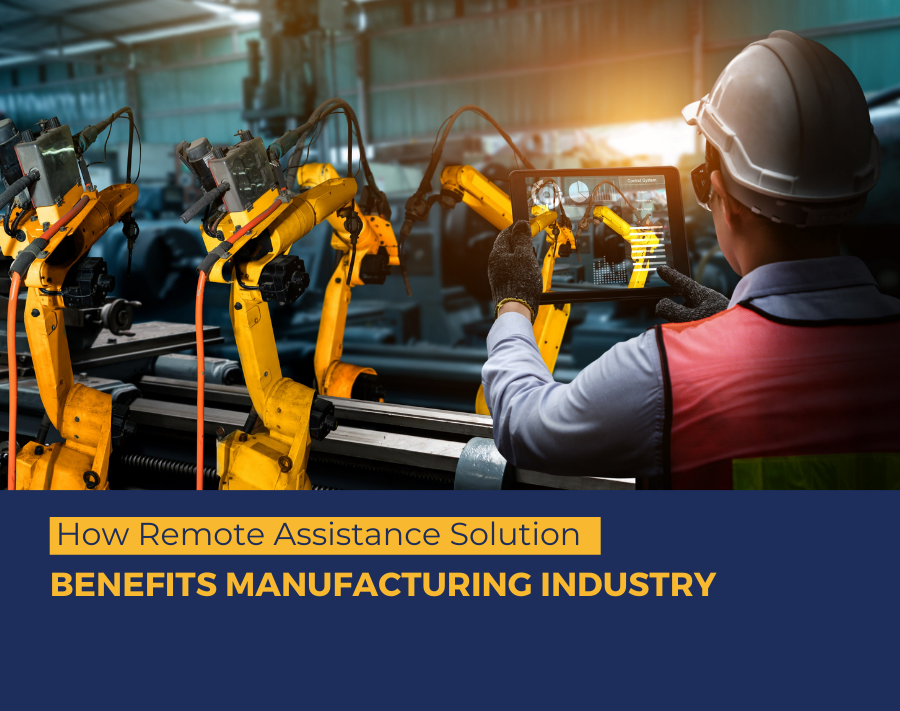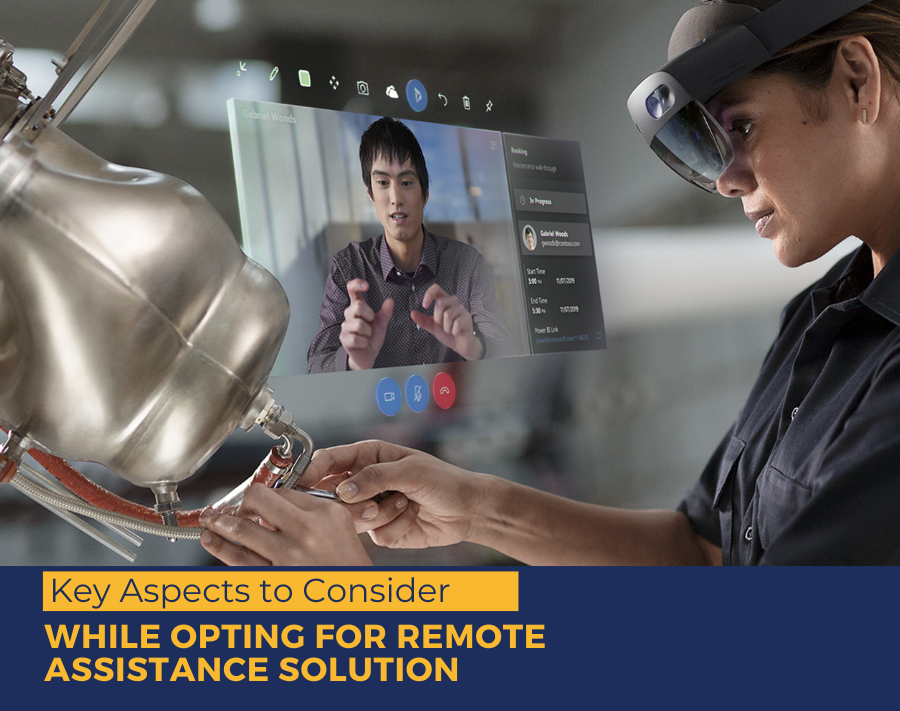AR technology is not about enhancing the gaming experience anymore! Various industry sectors have started leveraging its potential for improving various processes worldwide. AR has disrupted the operating processes of many businesses across different sectors by offering highly efficient solutions to critical problems. One of its well-known solutions is the Augmented Reality in manufacturing remote assistance solution.
Like all major industries, AR remote assistance has a significant impact on the manufacturing industry. Every manufacturing plant is aimed at transforming the raw material into a finished product. Therefore, even the smallest issues can bring interruption to the whole process. As a manufacturer, you know the secret of success in this industry remains in continuing all the processes with physical, mechanical, and chemical interactions.
Talking about the role of augmented reality in manufacturing, it is fair to mention that it can have a huge impact especially when something gets wrong in the production processes. These days, the manufacturing industry is thriving at a rapid pace and many entrepreneurs believe in diversification as well as establishing plants in remote areas. Though both these concepts are lucrative, they are quite risky when something goes wrong.
An augmented reality remote assistance solution can act as a bridge between experts and field workers in this situation. AR technology can make operations efficient by reducing downtime and quickly identifying the issues. Let’s dig deep into the benefits of AR technology in bringing revolutions in the manufacturing industry.
Major Benefits of AR Remote Assistance in Manufacturing Sector
Here we make a list of a few noteworthy benefits of AR remote assistance-
1. Quicker, Automated Work
Working on the production line, inspecting products, and fixing issues of equipment require the complete attention of field workers. Thanks to an AR-based remote solution, live annotations, and other features can bring automation, and field workers can work hands-free while receiving instructions in real-time. With this AR-based remote collaboration, the accuracy of field workers can increase up to 96% and they can work 30% more quickly.
2. Reduced Maintenance Time
Many machines are exposed to dust, extreme temperatures, and pressures, and therefore, they are highly vulnerable to various issues. But, if a breakdown occurs, the entire augmented reality in manufacturing process is interrupted. Field workers can find it difficult to stay organized and remain calm in such a situation. AR remote assistance can offer the fastest and most effective solution for having real-time support and collaboration.
Also Read- Top Seven Enterprise-Grade Use Cases of AR Remote Assistance
3. Reduced Production Downtime
Any augmented reality in manufacturing company has a serious threat in the form of production downtime. It may occur due to machine breakdown or any sort of malfunction. AR remote support enables field workers to get real-time instructions on their smart devices. As a result, they can quickly resolve their issues and prevent downtime. Augmented Reality remote assistance solution can enable the remote team to monitor, inspect, update, and repair machinery for creating the right atmosphere for reducing production downtime.
4. Easy Data Access and Analysis
AR remote assistance promotes collaboration between experts and remote workers by enabling them to share necessary data in the forms of images, PDF files, and 3D models. Field workers can have seamless access to data and they can use the same as and when necessary to resolve a similar issue. AR-based remote assistance solution has a built-in archive for previous sessions for instant reference.
5. Reduced Human Errors
A customized AR remote assistance solution brings automation to the maintenance and repair processes. It can empower remote workers to fix all the issues thereby reducing human errors. The right direction in real-time can assist your company to reduce the chances of any human errors in handling or repairing the equipment. More efficient solutions and operations can increase productivity with the help of AR-powered remote assistance solutions.
Here are the two most common use cases of remote assistance solutions for the manufacturing sector.
No Workforce Knowledge Gaps Anymore!
The manufacturing industry has many challenges to face. One of them is knowledge gaps between field workers or remote workforce and technicians. A customized remote assistance app can meet this challenge effectively through built-in archives or a knowledge base.
Key Challenges Remote Assistance Solution Addresses
- Traditionally, experts visit the manufacturing plant and resolve the issue at their convenience
- Usually, a few field workers come in contact with the expert who is present at the plant for servicing or repairing the equipment
- There is little or no exchange of data among workers related to the machine’s issue and how experts have solved it
- In the traditional method of repairing or maintaining the equipment, there is no possibility to refer to the previous solution if the same issue occurs again
- Field workers have no idea on how to resolve the issue as their dependency on experts is very high due to a lack of knowledge
- At times, experts take significant time in visiting the remote plant, and as a result, the manufacturing company has to suffer a prolonged downtime and its employees’ efficiency reduces significantly
Solution
- Augmented reality remote assistance app has a built-in base for storing necessary information related to previous maintenance and repair sessions
- Experts can save useful data in different formats like PDF, audio files, and the like in archives
- Remote workers have seamless access to data as and when issues occur
Outcome
The remote workforce can get access to all the data related to previous issues and the same issues can be resolved easily using the available data. There is no need to communicate with experts for the same issue thanks to this feature.
Two-way Collaboration is Possible!
Two-way, real-time collaboration can increase machine uptime significantly with the quick fixing of issues. A customized remote assistance app can make two-way collaboration effective.
Key Challenges Remote Assistance App Addresses
- Experts or technicians may not free to visit the remote plant and traveling can also take time
- Without proper communication and real-time collaboration, it is not possible for workers to resolve the issues
- If issues persist for a long time, the result will be prolonged downtime and reduced productivity
- Remote workers or employees find it very frustrating that even if they want to fix the issue, they cannot do it without an expert’s help
- Lack of collaboration can worsen the issue at times, and remote staff may remain at risk
Solution
- AR remote assistance application facilitates two-way collaboration between field workers and remote technicians.
- Real-time chat, conference call, and audio or video calling facilities are useful for instant communication and effective collaboration
- Digital annotations can make collaboration more interactive and productive for field workers and technicians alike
Outcome
Real-time assistance with two-way collaboration can reduce the time for resolving the issue and overall downtime. Companies can reduce downtime and increase productivity.
Rejig Digital has developed a purpose-built, AR-based app for remote assistance, known as Ally. Whether your remote employees want to connect to technicians or experts, Ally always makes it possible with digital annotations and AR-based features in real-time.
You can save big on various costs in your manufacturing plant using Ally. Just send us an email with your remote assistance requirements at info@rejigdigital.com and we will contact you soon.





